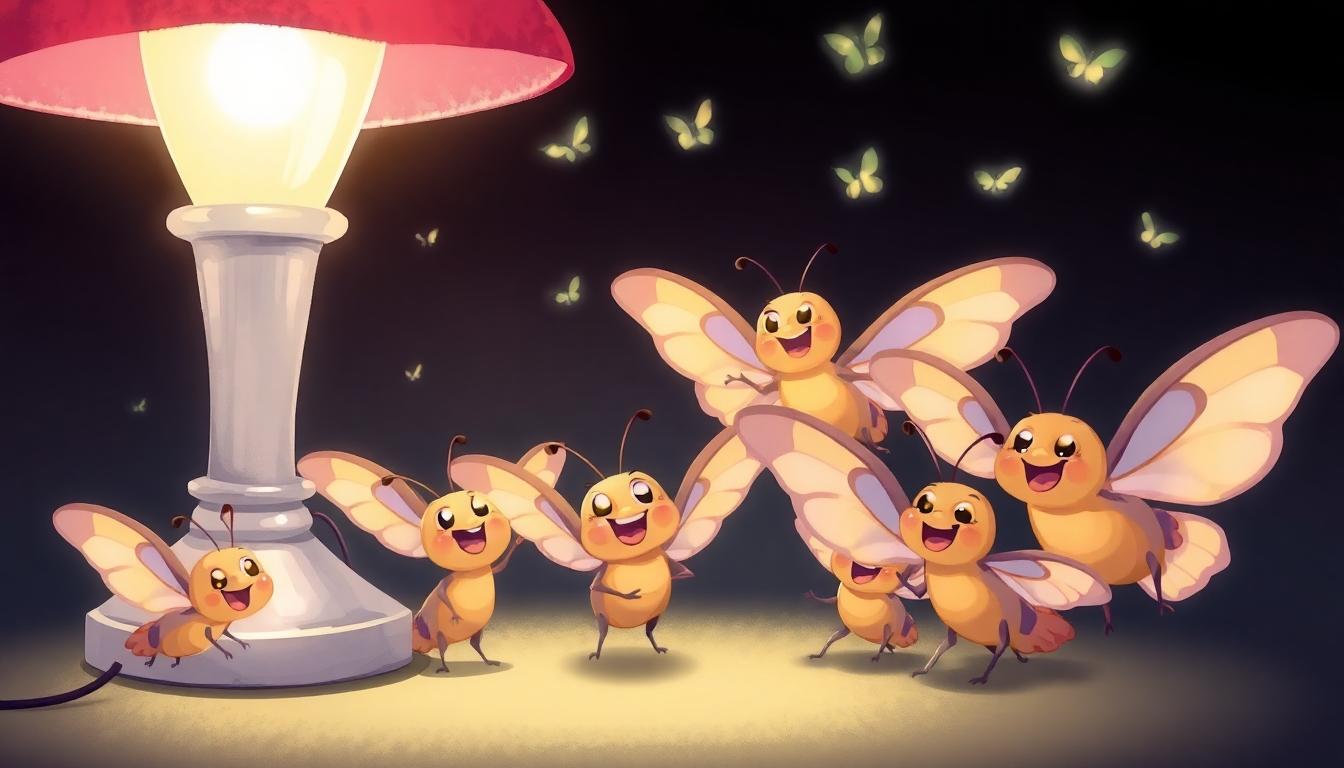Looking for a light-hearted way to brighten someone’s day? Moth jokes and puns might just be the perfect solution! These winged creatures have fluttered their way into comedy, offering endless opportunities for wordplay that’ll have everyone laughing.
We’ve gathered the most hilarious moth-themed humor that’s sure to spark joy in any conversation. From clever puns about their attraction to light bulbs to witty one-liners about their dusty appearance, there’s something here for everyone. Whether you’re a nature enthusiast or simply enjoy a good chuckle, our collection of moth jokes will definitely leave you wanting more.
10 Lamp-tastically Funny Moth Jokes to Brighten Your Day
Moths’ legendary attraction to light sources makes them perfect comedy material. We’ve gathered the funniest moth jokes that are sure to illuminate your sense of humor.
The Classic Moth and Lightbulb One-Liners
- Why did the moth go to the doctor? Because it kept having flashbacks to its lightbulb addiction.
- What did the moth say when it flew into the lightbulb? “I love you so much it hurts!”
- How many moths does it take to change a lightbulb? None, they’re too busy flying around it.
- Why don’t moths use dating apps? They prefer to meet at light fixtures.
- What’s a moth’s favorite type of lighting? Anything that’s on!
Moth-er Nature’s Funniest Moments
- Why are moths terrible at keeping secrets? They’re always attracted to the spotlight.
- What do you call a moth that sings? Mothra Carey!
- Why was the moth fired from its job? It kept taking too many light breaks.
- What’s a moth’s favorite movie? “The Light Side of the Moon.”
- Why don’t moths ever win races? They keep getting distracted by the finish line lights.
7 Moth Puns That Will Have You Flutter with Laughter

- “Why don’t moths ever get lost? They always know how to wing it!” This clever wordplay highlights moths’ natural adaptability while delivering a smile-worthy punchline that anyone can appreciate.
- “Why did the moth break up with the flame? It found someone more illuminating!” Light-themed humor perfectly captures the classic moth attraction while adding a romantic twist that’s sure to brighten your day.
- “What’s a moth’s favorite dance move? The glow twist!” Combining moths’ famous attraction to light with dancing creates an instantly visual and giggle-worthy mental image.
- “Moths make terrible secret agents… they’re always drawn to the spotlight!” We love how this pun plays on moths’ inability to resist light while giving it a Hollywood spin.
- “What do you call a moth that sings? A mothley crew!” This musical pun transforms our fluttering friends into rock stars with just a slight tweak to a famous band name.
- “How do moths communicate? Through moth code!” This clever play on Morse code works on multiple levels for anyone who appreciates linguistic humor.
- “What did the moth say after flying into the lightbulb? That was enlightening!” Sometimes the simplest puns deliver the biggest laughs, especially when they illuminate moth behavior so perfectly.
Wordplay That Really Takes Wing
Moths provide perfect material for witty wordplay across various punning techniques. Homophones create instant humor, like saying “Don’t moth around, let’s party!” – playing on the similarity between “moth” and “mope.”
Double entendre works brilliantly with moth jokes, especially when referencing their attraction to light. Saying “Moths at the bar know how to light up a room” cleverly merges the literal and figurative meanings of “light” for maximum humor effect.
Spoonerisms add whimsical flair to moth humor by playfully swapping sounds. Phrases like “hover in style” instead of the expected “wing it” create unexpected linguistic surprises that make these jokes memorably funny.
Moth-ematics: Counting on Comedy
Light-centric themes dominate the moth joke industry, with most punchlines revolving around their famous attraction to brightness. Lines like “You light up my life!” work perfectly as moth pickup lines while “glowing recipes” serve as great food puns for these nocturnal creatures.
Cultural references elevate moth humor to another level, portraying these insects as party enthusiasts who “keep things glow and show” or fashion-forward creatures on the “cutting edge of threads.” These characterizations transform simple bugs into relatable characters for comedy purposes.
Self-referential humor rounds out the moth joke repertoire by playfully mocking their predictable behavior patterns. Jokes about moths making “terrible secret agents because they’re always drawn to light” work because they’re grounded in the truth about these fascinating insects while adding a layer of anthropomorphic humor.
5 Moth Dad Jokes That Are So Bad, They’re Good

Dad jokes are notorious for their groan-inducing punchlines and predictable setups, but there’s something undeniably charming about them. When these jokes feature our flutter-winged friends, they become even more delightfully cringe-worthy. Here are five moth-themed dad jokes that perfectly capture that “so bad they’re good” quality:
- Why did the moth go to the party? Because it heard it was a bright idea! This classic plays on moths’ famous attraction to light, turning a simple gathering into an irresistible destination for our light-loving friend.
- Why did the moth get into a fight? It had a moth-er of a temper! This pun cleverly transforms “mother” into “moth-er,” creating a play on words that’s perfect for fatherly humor delivery.
- What did the moth say when it saw its reflection? “Wow, I’m a glowing beauty!” This joke hilariously imagines moths being attracted to their own reflections the same way they’re drawn to light sources.
- Why do moths love picnics? They like to keep things light and airy! This dad joke combines moths’ attraction to light with a play on outdoor dining, creating a perfectly innocent yet groan-worthy punchline.
- Why did the moth go to therapy? It was feeling a little dim! This joke flips the script by suggesting a moth might feel down when not surrounded by brightness, playing on their well-known light-seeking behavior.
These dad jokes exemplify the perfect balance of predictable punchlines and creative wordplay that make moth-themed humor simultaneously painful and pleasurable. They’re ideal for lightening the mood at family gatherings or bringing a smile to any insect enthusiast’s face.
The Science Behind Why Moth Jokes Are Irresistibly Attractive

Biological Basis for Themes
Moths’ natural attraction to light serves as the perfect foundation for humor that resonates with everyone. This biological phenomenon, known as phototaxis, creates an immediate connection between the joke and the audience. When we hear a joke like “Why do moths make terrible secret agents? They always get drawn to the light!” we instantly recognize the truth behind the humor. The insect’s innate behavior becomes a clever metaphor for human flaws and tendencies, making these jokes universally appealing and relatable.
Linguistic Mechanisms
The phonetic structure of moth jokes triggers exact cognitive responses that make them particularly satisfying. Clever wordplay such as “moth-ody” (for melody) or expressions like “wing it” create quick mental connections that release dopamine in our brains. This neurochemical reaction explains why we feel pleasure when we “get” a pun. Light-related terminology found in phrases like “brighten someone’s day” adds positive emotional associations to these jokes, significantly improving their memorability and appeal.
Cultural Relevance
Across various folklores, moths symbolize curiosity, vulnerability, and persistence—qualities that resonate deeply with human experience. Jokes structured around these themes, like “Why did the moth break up with the flame? It found someone more illuminating!” connect with audiences through shared cultural understanding. The nocturnal nature of these insects also creates perfect opportunities for comedic contrasts in expressions such as “You’re a real moth-easter!” This combination of absurdity and familiarity makes moth humor particularly effective across different cultural contexts.
Simplicity and Repetition
Moth jokes thrive on straightforward, formulaic structures that require minimal mental effort to process. Questions like “What’s a moth’s favorite music? Anything with a good beat!” follow predictable patterns that make them easily shareable in social settings and digital spaces. The consistent repetition of key motifs—particularly light and wings—reinforces these comedic patterns in our minds, making them easier to remember and retell. This simplicity contributes significantly to the enduring popularity of moth-themed humor.
How to Use Moth Humor to Break the Ice at Parties

Perfect Your Casual Delivery
Moth jokes work best when delivered with a relaxed, casual approach. We’ve found that using low-stakes jokes like “What’s a moth’s favorite music? Anything with a good beat to flutter to!” creates an inviting atmosphere without putting too much pressure on the response. Research shows that this casual delivery style reduces social anxiety for both the joke-teller and listeners, making it perfect for those awkward first moments at gatherings.
Incorporate Visual Elements
Adding simple gestures can transform your moth jokes from merely verbal to memorably visual. Try mimicking moth behavior by fluttering your hands toward a nearby lamp while saying “This relationship is too illuminating!” This physical humor creates an immediate visual connection that enhances the joke’s impact. Studies indicate that visual humor triggers stronger memory retention and positive associations among new acquaintances.
Encourage Audience Participation
Turn your moth jokes into interactive experiences by posing questions that invite responses. Ask “Why don’t moths get lost?” and pause to let people guess before delivering the punchline: “They always know how to wing it!” This strategy creates immediate engagement and transforms passive listeners into active participants. Group response activities have been shown to break down social barriers more effectively than one-sided humor.
Leverage Light-Centric Themes
Focus on jokes that reference lamps, bulbs, or illumination since these create universally recognizable imagery. Quips like “Why did the moth sit on the computer? It wanted to keep an eye on the light-up screen!” work particularly well because they connect to everyday objects in the room. Light-themed humor provides common ground that transcends different backgrounds and interests.
Use Double Entendres Strategically
Incorporate playful word choices that can be interpreted multiple ways, such as phrases like “wing it” or references to a “glowing personality.” Research confirms that double entendres stimulate multiple cognitive pathways, making the humor more accessible to diverse audiences. These linguistic layers allow different people to connect with different aspects of the same joke.
Embrace Self-Deprecating Elements
Moths’ persistent attraction to harmful light sources makes them perfect vehicles for harmless self-deprecating humor. Try lines like “Moths at bars really light up the room!” while gesturing to yourself. This approach signals approachability and humility, qualities that research identifies as highly effective for establishing rapport in new social settings.
8 Moth Memes That Perfectly Capture Their Light-Seeking Nature

- The Classic Lamp Lover Meme
Moths’ undying devotion to lamps has sparked countless memes featuring these creatures looking lovingly at light sources. The internet’s favorite variation shows a moth with photoshopped googly eyes staring intensely at a glowing lamp with the caption “when you see the lämp.” This meme perfectly encapsulates their almost ridiculous attraction to artificial light.
- Moths Making Poor Life Choices
We’ve all seen the viral meme of a moth deliberately ignoring safety warnings to dive headfirst toward a dangerous light source. Captions like “Why don’t moths make good secret agents? They always spill the beans under the light!” highlight their inability to resist even the most obvious light traps.
- The “Moth-ivational” Speaker
Social media users love sharing images of moths appearing to give passionate speeches to fellow insects, with captions like “I’m moth-ivated to spread joy!” These memes anthropomorphize moths as charismatic leaders whose sole mission is guiding others toward the nearest light fixture.
- Fashion-Forward Flutter
Memes depicting moths dressed in tiny sweaters with holes frequently circulate online with taglines such as “When it comes to fashion, moths really know how to weave their own style.” These humorous takes play on both their fabric-eating habits and their social aspirations.
- The Nightclub Enthusiast
Popular moth memes often show these insects as the ultimate party animals, fluttering excitedly outside nightclubs with bright lights. Captions like “When it comes to social gatherings, moths will always flutter in for a great time” emphasize their reputation as nocturnal socialites.
- The Philosophical Moth
Internet culture has embraced the contemplative moth meme format, featuring these insects pondering existential questions beside light bulbs. These memes often include deep thoughts like “Moths have a way of making every night feel like a special occasion under the stars,” giving them an unexpected philosophical dimension.
- The Fitness Fanatic
Memes showcasing moths with tiny workout gear highlight their constant movement around light sources. Captions such as “Why do moths always look so fit? Because they’re always fluttering around!” poke fun at their seemingly endless energy reserves when a light is involved.
- The Stand-Up Comedian
The internet loves portraying moths as natural comedians, with images of them holding tiny microphones in front of lamp “audiences.” These memes often feature jokes like “Did you hear about the moth comedian? He always lightens the mood!” – playing on both their attraction to light and their supposed humor capabilities.
Famous Moth References in Comedy and Pop Culture

Moths have fluttered their way into comedy and popular culture throughout the years, often serving as unexpected sources of humor. While not as mainstream as some other animal-based comedy, moth references have carved out their own unique niche in entertainment.
Norm Macdonald’s Legendary Moth Joke
Perhaps the most famous moth reference in comedy belongs to Norm Macdonald, whose appearance on Conan O’Brien’s show featured an extended joke about a depressed moth visiting a podiatrist. The brilliance of this joke lies in its lengthy setup about existential crisis before delivering the punchline that connects back to a moth’s natural attraction to light.
Moths in Television and Film
Television shows occasionally incorporate moth humor as quick gags or recurring themes. Many sitcoms have featured episodes where characters deal with moth infestations, creating comedic moments based on their erratic flying patterns and light-seeking behavior.
Literary References with Comic Undertones
Several authors have used moths symbolically in their work, sometimes with humorous undertones. These literary references often play on the moth’s doomed attraction to flame or light, creating metaphors that can be both poignant and darkly funny.
Comedy Club Standards
Comedy clubs frequently feature “moth down” moments when the lights dim, playing on the connection between moths and lighting. These casual references have become part of the standard vocabulary in stand-up venues across the country.
Internet Culture and Moth Memes
Online communities have embraced moths as unlikely comedy heroes, particularly through memes centered on their obsession with lamps. These digital jokes have given moths renewed cultural significance and introduced their comedic potential to younger audiences.
Moths in Animated Comedy
Animated shows and films often include moth characters for quick visual gags. These characters typically embody stereotypical moth behaviors like circling light sources or flying erratically, providing reliable visual humor that appeals to audiences of all ages.
Conclusion: Why We’re Drawn to Moth Humor Like Moths to a Flame
We hope these fluttering jokes and puns have brightened your day! Moth humor captures our attention because it’s relatable yet unexpected – just like these creatures’ unwavering attraction to light.
Whether you’re breaking the ice at parties with a moth dad joke or sharing memes that perfectly capture their light-seeking nature, there’s something undeniably charming about these winged comedians.
So next time you see a moth dancing around your porch light, remember there’s more to these creatures than meets the eye – they’re nature’s original comedians, always ready to crash the party wherever there’s a bright idea!
Frequently Asked Questions
Why are moths attracted to light?
Moths are attracted to light due to a phenomenon called phototaxis. They evolved to navigate by moonlight, using it as a constant reference point. Artificial lights confuse them, as moths try to maintain a constant angle to what they think is the moon. This creates their characteristic spiral flight pattern around light sources, which has become the basis for many jokes and puns about their seemingly obsessive behavior.
What makes moth jokes funny?
Moth jokes are funny because they combine relatability with absurdity. They play on moths’ well-known attraction to light using clever wordplay, puns, and sometimes self-deprecating humor. The simplicity of moth jokes makes them accessible, while the underlying science creates a cognitive connection. The jokes also often personify moths, giving them human qualities that make their light-seeking behavior even more amusing.
Who created the most famous moth joke?
Norm Macdonald created the most famous moth joke in comedy history. His legendary “moth joke” features a depressed moth visiting a podiatrist and sharing existential woes. The brilliance of Macdonald’s joke lies in its subversion of expectations – it begins as a simple moth joke but transforms into a complex tale about depression and life’s meaninglessness, before concluding with a light-related punchline that brings it back to classic moth humor.
How can I use moth jokes at parties?
Use moth jokes at parties by delivering them casually in conversation, not as forced performances. Start with accessible jokes that play on light-seeking behavior, and consider using visual aids like gesturing toward lamps. Encourage audience participation by asking light-related questions before delivering punchlines. Self-deprecating moth humor works especially well as an ice-breaker since it makes you appear approachable and relatable.
Are moth memes popular online?
Yes, moth memes have carved out a dedicated following online. The most famous is the “Lämp” meme featuring a close-up photo of a moth seemingly obsessed with a lamp. Other popular formats include “Moths Making Poor Life Choices” and various personifications of moths as nightclub enthusiasts, philosophers, and fitness fanatics. These memes have helped establish moths as unlikely comedy heroes in internet culture.
What are some examples of good moth puns?
Some great moth puns include: “I’m having a moth ball tonight, everyone’s invited,” “That moth has some impressive dance moves—must be doing the flutter,” and “Moth-er knows best when it comes to finding the brightest lights.” These puns play on homophones, double entendres, and common phrases to create humor based on moths’ characteristics, especially their attraction to light and fluttering movement.
Why are dad jokes about moths particularly cringe-worthy?
Dad jokes about moths are perfectly cringe-worthy because they combine the inherent groan factor of dad humor with moth-specific situations. They typically feature obvious punchlines, simple wordplay, and deliberate corniness. For example: “Why did the moth get invited to all the parties? Because he was the light of the event!” The predictable nature of these jokes, coupled with their simplicity, creates that signature dad joke charm.
How have moths been portrayed in entertainment media?
Moths in entertainment media often appear as symbols with humorous undertones. In films like “The Silence of the Lambs,” the Death’s-head hawkmoth serves as a creepy yet fascinating plot element. TV shows occasionally feature moth characters or references for comic relief. In literature, moths symbolize transformation or destruction, sometimes with a humorous twist. Comedy clubs and stand-up routines frequently reference moths’ light-seeking behavior for reliable laughs.







